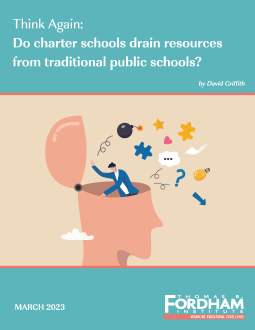Opponents of public charter schools frequently contend that they drain resources from traditional public schools—a potentially serious charge. But of course, it makes sense that traditional school districts get less money when they enroll fewer students. So from a policymaking perspective, the real question is whether districts’ financial capacity to meet students’ needs is compromised by charters’ presence. This brief addresses that question and several key subquestions by synthesizing the latest and most rigorous research on charters’ fiscal and academic impacts on district schools.
Download the full brief or read it below.
Executive Summary
Q: Do charter schools increase or decrease districts’ total revenues per pupil?
A: Charter schools may increase or decrease districts’ total revenues per student, depending on who authorizes them, how they impact the local housing market, and the policies that states and localities adopt.
Q: Do charter schools increase or decrease districts’ instructional spending?
A: Competition from charters may push districts to increase or decrease their instructional spending (though it has mostly positive effects on specific instructional inputs such as teacher salaries).
Q: Do charter schools make districts more or less efficient?
A: While few studies address the efficiency question directly, what we do know suggests that charters make affected school districts more efficient, at least in the long run.
The Bottom Line
In the long run, districts will adjust to charter-driven enrollment declines, just as they do when their enrollments fluctuate for other reasons, so the challenge for policymakers is managing any transition costs—that is, any temporary fiscal or operational challenges that districts face—in a way that is fair to students and taxpayers.
Recommendations
1. Ensure that local dollars follow students to charters on an equitable basis.
2. Ensure that any compensatory funding that districts with declining enrollments receive is temporary.
3. Prioritize the needs of displaced students in cases where the consolidation of under-enrolled district schools is inevitable.
––––––––––––
Introduction
Opponents of public charter schools often claim that they drain resources from traditional public schools.[1] Yet from the standpoint of educating children, the real question is whether districts’ finances and capacity to meet students’ needs are compromised by charters’ presence.
To address that question, this brief synthesizes the latest and most rigorous research on three important subquestions: First, do charters increase or decrease districts’ total revenues per pupil? Second, do they increase or decrease districts’ instructional spending per pupil? And finally, does their presence make districts more or less efficient?
Question 1
Do charter schools increase or decrease districts’ total revenues per pupil?
Contrary to public perception, the logical implication of many local, state, and federal policies is that districts’ total revenues per pupil increase when students exit the system for charter schools. For example, in thirty-seven of the forty-six states where they exist, charters are at least partially excluded from local funding sources,[2] which account for 45 percent of total K–12 education funding. Consequently, districts’ local revenues per pupil increase mechanically insofar as students, but not the associated tax dollars, exit the district system.
As for state funding, many states have adopted “hold harmless” policies that temporarily shield school districts from the declines that would otherwise be associated with declining enrollment,[3] as well as other policies that subsidize smaller districts.[4] And a few states, such as Massachusetts[5] and New York,[6] compensate districts specifically for charter-driven enrollment losses.
Finally, although they account for just 8 percent of total K–12 education revenues, all four parts of the federal Title I program have time-limited hold harmless provisions,[7] as well as other wrinkles that could potentially benefit districts when they lose students to charters.[8]
Importantly, some research suggests that the presence of charters has reduced residential property values and, by extension, local revenues per pupil in Rust Belt states such as Michigan,[9] Ohio,[10] and Pennsylvania (where the effect was partly offset by compensatory state policy).[11] Yet other studies paint a more positive picture. For example, one Massachusetts study found that charters increased districts’ total revenues per student.[12] And while analyses of charters’ impacts in Arizona,[13] California,[14] New York,[15] Texas,[16] and Utah[17] didn’t directly examine the question of total revenues per pupil, in at least some of these cases, total spending per pupil appears to have increased.
In addition to these state-specific analyses, one national study found negligible effects on districts’ total revenues per pupil.[18] And a recent quasi-national analysis published by the Fordham Institute that focused on “independent” charters—that is, those not authorized by the “host” school district—found positive or null effects on districts’ local, state, federal, and total revenues per pupil in most of the states it considered.[19]
In short, research suggests that charter schools may increase or decrease districts’ total revenues per pupil depending on who authorizes them, how their arrival impacts the local housing market, and—perhaps most important—the policies that states and other jurisdictions adopt.
Question 2
Do charter schools increase or decrease districts’ instructional spending?
Although its precise definition varies by jurisdiction, the term “instructional spending” is generally understood to refer to the monies a school system spends on salaries and benefits for teachers and their classroom aides, as well as textbooks and other classroom materials. In other words, it is spending that is clearly related to students’ experiences in the classroom, as opposed to administration or facilities.
If the presence of charter schools were clearly associated with declines in districts’ instructional spending per pupil, critics would have a solid foundation upon which to build their case. Yet, like the research that examines charters’ effects on districts’ revenues, the research that examines their effects on districts’ instructional spending per pupil highlights the importance of state and local context, including but not limited to policies that determine districts’ total revenues per pupil. For example, the aforementioned studies of Ohio, Pennsylvania, and California all found declines in instructional spending, both in absolute terms and as a share of total spending.[20] In contrast, both an early study of charter school competition in Michigan[21] and a more recent Utah study found null effects.[22] And in Massachusetts[23] and New York City,[24] instructional spending per pupil increased.
In Fordham’s study of “independent” charters, an increase in the share of local students who enrolled in independent charters was associated with a significant increase in districts’ instructional spending per pupil in eight states. And in another twelve states, there was no significant effect in either direction (though these results don’t necessarily generalize to district-affiliated charters).[25] In other words, many of the places where research suggests an increase in total revenues per pupil may have also experienced an increase in instructional spending—or at least, no significant change—while the places where research suggests a decline in total revenues per pupil may have also experienced a decline in instructional spending.[26]
Notably, in addition to instructional spending per pupil, researchers have examined the effects that competition from charter schools has on specific instructional inputs. For example, while the Michigan study found no effects on average teacher salaries or class sizes,[27] a study of charters’ fiscal spillovers in Albany and Buffalo found that student-teacher ratios declined in district schools.[28] Similarly, while the California study found a small decline in district teachers’ salaries,[29] studies of teacher labor markets in Massachusetts,[30] North Carolina,[31] and Texas[32] reached the opposite conclusion.
In short, competition from charters may push districts to increase or decrease instructional spending per pupil depending on the circumstances, but it seems to have mostly positive effects on specific instructional inputs.
Question 3
Do charter schools make districts more or less efficient?
At the heart of the debate over charters’ fiscal spillovers is the claim that they increase districts’ fixed costs per pupil, thus making them less efficient. Yet in practice, classifying costs as “fixed” or “variable” is a slippery business. For example, districts in some states are at least theoretically required to provide services such as “textbooks, computer hardware and software, pupil transportation, pre-K services, and health services” to all resident students, including those in charters.[33] Consequently, making apples-to-apples comparisons can be challenging when it comes to spending on these items.
Because of these complexities, many studies have focused on things like higher per-pupil expenditures on building maintenance, which are often taken as evidence that district schools have become “inefficiently small.”[34] No doubt there is a grain of truth to this allegation, at least in places where district enrollment declines in absolute terms. Still, insofar as charter-driven increases in noninstructional spending are evidence of inefficiency, districts aren’t powerless. For example, after years of charter-driven enrollment losses, in 2013 the District of Columbia Public Schools consolidated fifteen chronically under-enrolled campuses,[35] while the Chicago Board of Education voted to close at least fifty school buildings.[36]
As those examples suggest, distinguishing between short- and long-run effects is critical to any discussion of districts’ fixed costs. For example, the California study mentioned above finds evidence that “districts may be more able and willing to respond to charter school competition across longer time horizons, or when competition reaches a certain threshold.”[37] Yet most studies of charters’ fiscal side effects make no real effort to explore this possibility.
Worse, by focusing on districts’ fixed costs per pupil as opposed to their return on investment, most studies implicitly discount the possibility that districts with a sizable charter presence get more bang for their buck. After all, charter schools are plausibly associated with any number of changes in districts’ organization and operation. For example, competition from charters could lead to more “inefficiently small” district schools, subsequently prompting beneficial changes to districts’ human-capital policies or operations, such as more rigorous evaluations or a more flexible pay schedule. In other words, an increase in districts’ “fixed costs per pupil” doesn’t necessarily imply a lower return on taxpayers’ investment.
Importantly, the research on charters schools’ academic impacts on district schools has become increasingly positive in recent years. For example, at least twelve studies that rely on student-level data have now found positive effects on districts’ achievement,[38] while seven others have found mixed or neutral effects,[39] and just three (increasingly outdated) studies have found effects that are unambiguously negative.[40] Similarly, some recent studies have found that competition from charters improves district students’ attendance and behavior (though there is less evidence when it comes to these outcomes).[41]
Ironically, the logical implication of these findings is that, insofar as charters are marginally reducing districts’ total revenues per pupil, they are also making them more efficient. And conversely, increases in district students’ achievement aren’t necessarily evidence of greater efficiency insofar as districts reap a fiscal windfall.
Unfortunately, research that addresses the question of return on investment is hard to come by; however, a recent study of charters’ fiscal impacts on district schools in New York State provides an intuitive starting point. On average, the authors find that charters’ arrival leads to short-term cost increase in host districts. However, this negative finding is “offset by efficiency gains in the long term” (by which the authors mean anywhere from one to eight years after a charter arrives). Consequently, districts with higher levels of charter penetration achieved “net reductions in the expenditures used to achieve a given level of outcomes.”[42]
In short, while few studies address the efficiency question directly, what we do know suggests that charters tend to make affected school districts more efficient, at least in the long run.
The Bottom Line
In the long run, districts that lose students to charter schools will adjust their behavior, much as they do in response to the inevitable changes in local demographics.[43] And with the right incentives, forward-thinking districts might adjust their behavior sooner rather than later. In other words, the challenge for policymakers is managing whatever transition costs are associated with moving to a more choice-based system in a way that is fair to students—regardless of what sort of school they attend—while also encouraging decisions that are fair to taxpayers.
In general, insulating districts from the fiscal pressures associated with enrollment declines is the wrong way to approach that challenge; however, insofar as districts are granted some sort of grace period—that is, insofar as policymakers allow their revenues per pupil to increase temporarily—the associated costs should be borne by the general public, not the disproportionately low-income and minority students whose parents or guardians choose to send them to a public charter school.
Recommendations
1. Ensure that local dollars follow students to charters on an equitable basis.
For example, California and Florida use identical funding formulas to allocate federal, state, and local funds to charter and traditional public schools.[44]
2. Ensure that any compensatory funding that districts with declining enrollments receive is temporary.
For example, Colorado funds districts based on their average enrollment over the past three years, while Nevada allows them to choose from the last two years.[45]
3. Prioritize the needs of displaced students in cases where the consolidation of under-enrolled district schools is inevitable.
For example, New Orleans’ common enrollment system prioritizes the preferences of students whose schools have closed, while local nonprofits offer information and assistance to their families.[46]
Endnotes
[1] Helen F. Ladd, How Charter Schools Undermine Good Education Policymaking (Boulder, CO: National Education Policy Center, August 2022), https://nepc.colorado.edu/sites/default/files/publications/PM%20Ladd_0.pdf.
Acknowledgments
This brief was made possible through the support of our sister organization, the Thomas B. Fordham Foundation. We are also grateful to Paul Bruno, Assistant Professor of Education Policy at the University of Illinois, for his helpful feedback on an early draft. At Fordham, we would like to thank David Griffith for authoring the report; Stephanie Distler for developing the report’s cover art and coordinating production; Victoria McDougald for her role in dissemination; and Chester E. Finn, Jr., Michael J. Petrilli, Amber Northern, Adam Tyner, and Jeanette Luna for reviewing later drafts. Thanks also to Pamela Tatz for copyediting.




